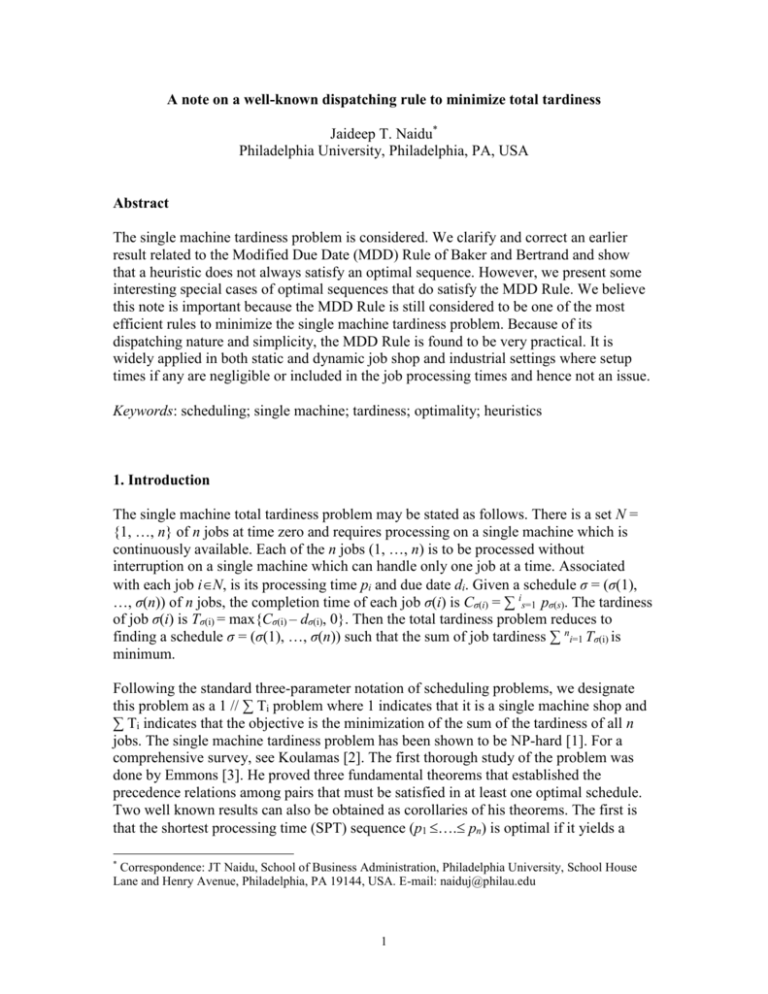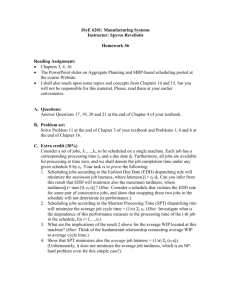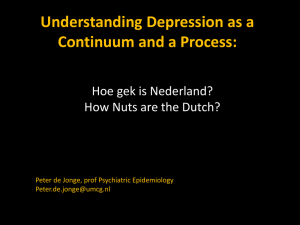A `Note` on a heuristic to minimize the single machine tardiness
advertisement

A note on a well-known dispatching rule to minimize total tardiness
Jaideep T. Naidu*
Philadelphia University, Philadelphia, PA, USA
Abstract
The single machine tardiness problem is considered. We clarify and correct an earlier
result related to the Modified Due Date (MDD) Rule of Baker and Bertrand and show
that a heuristic does not always satisfy an optimal sequence. However, we present some
interesting special cases of optimal sequences that do satisfy the MDD Rule. We believe
this note is important because the MDD Rule is still considered to be one of the most
efficient rules to minimize the single machine tardiness problem. Because of its
dispatching nature and simplicity, the MDD Rule is found to be very practical. It is
widely applied in both static and dynamic job shop and industrial settings where setup
times if any are negligible or included in the job processing times and hence not an issue.
Keywords: scheduling; single machine; tardiness; optimality; heuristics
1. Introduction
The single machine total tardiness problem may be stated as follows. There is a set N =
{1, …, n} of n jobs at time zero and requires processing on a single machine which is
continuously available. Each of the n jobs (1, …, n) is to be processed without
interruption on a single machine which can handle only one job at a time. Associated
with each job iN, is its processing time pi and due date di. Given a schedule σ = (σ(1),
…, σ(n)) of n jobs, the completion time of each job σ(i) is Cσ(i) = ∑ is=1 pσ(s). The tardiness
of job σ(i) is Tσ(i) = max{Cσ(i) – dσ(i), 0}. Then the total tardiness problem reduces to
finding a schedule σ = (σ(1), …, σ(n)) such that the sum of job tardiness ∑ ni=1 Tσ(i) is
minimum.
Following the standard three-parameter notation of scheduling problems, we designate
this problem as a 1 // ∑ Ti problem where 1 indicates that it is a single machine shop and
∑ Ti indicates that the objective is the minimization of the sum of the tardiness of all n
jobs. The single machine tardiness problem has been shown to be NP-hard [1]. For a
comprehensive survey, see Koulamas [2]. The first thorough study of the problem was
done by Emmons [3]. He proved three fundamental theorems that established the
precedence relations among pairs that must be satisfied in at least one optimal schedule.
Two well known results can also be obtained as corollaries of his theorems. The first is
that the shortest processing time (SPT) sequence (p1 …. pn) is optimal if it yields a
*
Correspondence: JT Naidu, School of Business Administration, Philadelphia University, School House
Lane and Henry Avenue, Philadelphia, PA 19144, USA. E-mail: naiduj@philau.edu
1
sequence where all jobs are tardy; and the second is that the earliest due date (EDD)
sequence (d1 … dn) is optimal if it yields a sequence where at most one job is tardy.
The first successful optimal procedure for the 1//TT problem was given by Potts and Van
Wassenhove [4] based on the decomposition theorem of Lawler [5] that can solve
problems up to 100 jobs. Based on these decomposition principles, a recent algorithm by
Szwarc et al. [6] reports optimal solutions for up to 500 jobs.
Since most job shop settings require very quick solutions, researchers [7, 8, 9] developed
efficient heuristics which generate very quick and approximate solutions even for very
large problem sets. One such heuristic is the well known MDD Rule [7]. In later work,
Panwalkar et al. [9] proposed the PSK Rule which was however shown to be equivalent
to the MDD Rule by Alidaee et al. [10]. The literature review suggests that few
researchers have explored the idea behind the MDD Rule. Rachamadugu [11] presented
local pair wise optimality conditions for the weighted tardiness problem and concluded
that the MDD Rule was a special case of the optimality condition. In this note, we show
that this conclusion is incorrect.
2. The MDD Rule of Baker and Bertrand
The MDD rule at any time schedules the next job from the set of all unscheduled jobs 'U‘
with the smallest priority index given by
i = {max{t + pi, di}}
where ‘t’ is the starting time of the next unscheduled job i (i U); pi is its processing
time, and di is its due date. Thus, if there are only two jobs j, k to be scheduled at time t,
job j precedes job k if max{t+pj, dj} max{t+pk, dk}.
Notice that the MDD Rule does not need a starting sequence unlike some other leading
heuristics. For instance, the PSK Rule [9] starts with the SPT sequence and the NBR
heuristic [8] starts with an EDD sequence requiring all jobs to be available at time t = 0.
In most practical situations, job shops have dynamic arrivals and the MDD Rule is found
to be very conducive to such settings.
3. Earlier Results and Discussion
Rachamadugu’s adjacent job condition [11]. Consider any two adjacent jobs j, k in an
optimal sequence for the single machine weighted tardiness problem. Either the following
condition holds or an alternate optimal sequence can be constructed by interchanging the
adjacent jobs in the optimal sequence :
(w[j] / p[j] ) [1 – (d[j] – t - p[j] )+ / p[k] ] (w[k] / p[k] ) [1 – (d[k] – t - p[k] )+ / p[j] ]
where [j] denotes the index of the job in the jth position, [k] denotes the index of the job in
the adjacent kth position, x+ denotes max(0, x) and t is the start time for job j.
2
By setting wi = 1 for all jobs, the above condition with a little algebraic manipulation, can
be rewritten as max (di, t + pi) max (dj, t + pj). Based on this result, Rachamadugu
presented Remark 1 related to the MDD Rule which is as follows.
Remark 1. For every average tardiness problem, some optimal sequence satisfies the
MDD Rule.
Remark 1 clearly states that for an ‘n’ job problem, if there are ‘m’ optimal sequences,
then at least one of those optimal sequences satisfies the MDD Rule. We claim that this is
incorrect and provide the following reasons. First, his result max(di, t+pi) max(dj, t+pj)
can be applied as an MDD Rule if there are only two jobs i, j that need to be scheduled.
However, the MDD Rule does not consider two jobs at a time when there are more than
two jobs that need to be scheduled. Instead, it considers the set of all unscheduled jobs
and chooses the job with the least priority index as stated earlier. Secondly, the adjacent
job condition of Rachamadugu [11] holds even for sequences that are not optimal. We
provide a counter example to demonstrate this.
A Counter Example and the Optimal Sequences.
Consider a set of 4 jobs with their processing times and due dates as shown below :
Job
pj
dj
1
2
8
2
14
15
3
3
17
4
4
17
We considered all 24 (4!) sequences this 4 job problem could generate. Of these, there
were a total of 4 optimal sequences (total tardiness equal to 8) with job 2 in the last
position in each of these sequences. The optimal sequences are as follows.
(i) [1, 3, 4, 2] ; (ii) [1, 4, 3, 2] ; (iii) [3, 1, 4, 2] ; and (iv) [4, 1, 3, 2].
Applying the MDD Rule results in the sequence [1, 2, 3, 4] with total tardiness equal to 9.
Observe that none of these optimal sequences satisfy the MDD Rule. The MDD Rule
schedules job 2 in position 2 and no optimal sequence will result by doing so. Another
observation is that the adjacent job condition of Rachamadugu [11] holds even for the
non-optimal sequence [1, 2, 3, 4]. It is important to note that these are only dominant
conditions and are not sufficient for optimality. Hence, these results are incorrect.
In the next section, we show that there however are some special cases of optimal
sequences that do satisfy the MDD Rule. We present and prove three such cases.
4. Optimal Sequences that satisfy the MDD Rule
We present three optimal sequences given by Emmons [3]. We then prove that each of
these optimal sequences also satisfies the MDD Rule.
Emmons’ Corollary 1.3. The SPT schedule is optimal if it is identical with the EDD
schedule.
3
We now present Proposition 1 as follows.
Proposition 1. If there is a sequence that satisfies the EDD and the SPT Rules, then the
resulting optimal sequence satisfies the MDD Rule.
Proof : Consider a set of jobs 1, …, n with p1 … pn and d1 … dn as shown below.
The current sequence 1, …, n is optimal according to Emmons’ Corollary 1.3.
Jobs
1 ……… n
Processing times p1……… pn
Due Dates
d1……… dn
At any given time t, we have max {t + pi , di } max i < k{t + pk, dk} where jobs 1, …, i-1
have already been scheduled. And based on the MDD Rule, job i will be picked at time t
for the next schedule. This concludes that the MDD Rule will pick exactly the same
sequence where p1 … pn and d1 … dn.
Emmons’ Corollary 2.2. The EDD schedule is optimal if it results in waiting (or starting)
times Wi di (i.e., Ci di + pi ) for all jobs i.
In other words, this corollary permits any or all jobs within an EDD sequence to possess
tardiness and still be an optimal solution, provided that no job possesses tardiness greater
than its processing time i.e., as long as ti pi i = 1,…, n. We next present Proposition 2
as follows.
Proposition 2. If there is an EDD schedule where ti pi i = 1, …, n, then the resulting
optimal sequence satisfies the MDD Rule.
Proof: Consider a set of jobs 1, 2, 3,…, n with d1 … dn and ti pi i = 1,…, n. This
sequence is optimal according to Emmons’ Corollary 2.2.
Jobs
Processing times
Due Dates
Tardiness
1
p1
d1
t1
2
p2
d2
t2
3
p3
d3
t3
……… n
……… pn
……… dn
……… tn
At time t = 0, consider at first only jobs 1, 2. The MDD Rule schedules job 1 first if
max{t + p1, d1} max{t + p2, d2}. We know d1 d2 and t2 p2. And t2 p2 p1 + p2 - d2
p2 p1 d2 t + p1 d2 (since time t = 0). Since t + p1 d2 and d1 d2, job 1 has a
lower priority index. And t + p1 dk k = 2, …, n (since d1 … dn). Thus job 1 has the
least priority index from the set of all jobs 1, …, n and thus scheduled first.
Now time t = p1. Consider jobs 2 and 3. The MDD Rule will schedule job 2 next if
max{t + p2, d2} max{t + p3, d3}. We know d2 d3 and t3 p3. And t3 p3 time + p2
+ p3 - d3 p3 time + p2 d3. Since t + p2 d3 and d2 d3, job 2 has a lower priority
index. And t + p2 dk k = 3, …, n (since d1 … dn). Hence the MDD Rule schedules
job 2 next since it has the least priority index from the set of all jobs 2, …, n.
It is now easy to conclude that the final sequence obtained by the MDD Rule will be
same as the current optimal sequence 1, …, n.
4
Emmons’ Corollary 1.4. The SPT schedule is optimal if all jobs are tardy i.e., if Ci > di
for all jobs i = 1, …, n.
Based on Corollary 1.4, we present Proposition 3 as follows.
Proposition 3. If there is an SPT sequence that satisfies the condition Ci > di i = 1, …,
n, then the resulting optimal sequence satisfies the MDD Rule.
Proof : Consider a set of jobs 1, …, n with p1 … pn and Ci > di i = 1, …, n.
This sequence is optimal according to Emmons’ Corollary 1.4.
Jobs
Processing times
Due Dates
1 ……… n
p1……… pn
d1……… dn
At time t = 0, the MDD Rule schedules job 1 first if max{t + p1, d1} max{t + pk, dk} k
= 2,…, n. Job 1 is tardy C1 > d1 t + p1 > d1. Thus max{t + p1, d1}= t + p1. And p1
pk k = 2, …, n (since p1 … pn). Hence p1 pk t + p1 t + pk k = 3,…, n. Now,
time t = p1. The MDD Rule will schedule job 2 next if max{t + p2, d2} max{t + pk, dk}
k = 3, …, n. Since job 2 is tardy, t + p2 > d2. Thus max{t + p2, d2} = t +p2. We know p2
pk k = 3, …, n (since p1 … pn). And p2 pk t + p2 t + pk. Hence job 2 has the
least priority index from the set of jobs 2, …, n and is thus scheduled next. It is now clear
that the final sequence obtained by the MDD Rule will be same as the current optimal
sequence 1, …, n.
5. Conclusions
We considered the well known MDD Rule to minimize the single machine total tardiness
problem. We corrected an earlier result related to this rule. In conclusion, we stated that
there may only be some special cases of optimal sequences that satisfy a heuristic. We
presented and proved three such cases that do satisfy the MDD Rule.
Acknowledgements – This research was partially supported by a summer grant from
Philadelphia University. Constructive comments from one anonymous reviewer
improved the quality of the paper.
References
[1] Du J and Leung JY-T. Minimizing Total Tardiness on One Machine is NP-Hard.
Mathematics of Operations Research 1990; 15: 483-495.
[2] Koulamas CP. The total tardiness problem: Review and Extensions. Operations
Research 1994; 42:6 1025-1041.
[3] Emmons H. One Machine Sequencing to Minimize Certain Functions of Job
Tardiness. Operations Research 1969; 17: 701-715.
5
[4] Potts CN and Van Wassenhove LN. A Decomposition Algorithm for the Single
Machine Total Tardiness Problem. Operations Research Letters 1982; 1: 177-181.
[5] Lawler EL. A ‘Pseudo-polynomial’ Algorithm for Sequencing Jobs to minimize
Total Tardiness. Annals of Discrete Mathematics 1977; 1: 331-342.
[6] Szwarc W, Grosso A and Della Croce F. Algorithmic paradoxes of the single
machine total tardiness problem. Journal of Scheduling 2001; 4: 55-71.
[7] Baker KR and Bertrand JW. A Dynamic Priority Rule for Scheduling against Duedates. Journal of Operational Management 1982; 3: 37-42.
[8] Holsenback JE and Russell RM. A heuristic Algorithm for Sequencing on One
Machine to minimize Total Tardiness. Journal of Operational Research Society 1992;
43: 53-62.
[9] Panwalkar SS, Smith M and Koulamas CP. A heuristic for the single machine
tardiness problem. European Journal of Operational Research 1993; 70: 304-310.
[10] Alidaee B and Gopalan S. A note on the equivalence of two heuristics to minimize
total tardiness. European Journal of Operational Research 1997; 96: 514-517.
[11] Rachamadugu RV. A note on the weighted tardiness problem. Operations Research
1987; 3: 450-452.
6






